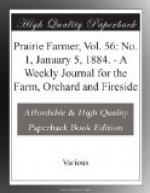I never found rat-traps much good; some of them would catch one or two, but after that the rest of the tribe would fight shy of all such devices for their undoing. A well trained rat terrier proved to be the best rat-trap we ever had on the premises, and for the poultry raiser who likes dogs a good ratter would be a good investment. Or you can use some one of the “exterminators” that may be obtained at the drug stores. Remove your fowls to some other building, prepare the poison according to directions, and place it in the poultry-house. The best kinds to use are those that make the rats thirsty and cause them to die immediately after drinking; water can then be left in the hen house and the dead rats will be found close by. When you have rat poison in the house see that it is properly marked and put out of reach of children and careless hired girls; and always see that all remnants of bait are taken care of.
A Nebraska man wants to know why his hens don’t lay. Says they are mostly early pullets, have a fairly comfortable poultry house, all the grain they will eat twice a day, and plenty of fresh water at all times.
It seems to me that “all the grain they will eat twice a day” is rather overdoing the grain business. Have some of that grain ground, mix with boiled vegetables and feed warm every morning; also give green food and raw bone, and my word for it your hens will soon “lay like sixty.”
FANNY FIELD.
FEATHER ENDS.
Plymouth Rock pullets are not always early layers, for they often grow for ten or twelve months before laying, though some say as early as six months after being hatched. The best plan the keep Plymouth Rocks is to get the pullets hatched as early as possible. April is as late as should be desired, but a Plymouth Rock cock crossed on common hens will produce pullets that may be hatched later.
N.Y. Times: A poultry-house should be large enough to be airy, but if it is kept strictly clean and sweet it will do no harm to be somewhat crowded. A house 24 feet long, 10 feet wide, 5 feet high behind and 8 feet in front, and having four roosting poles, all on a level and only a foot from the floor, will hold 60 to 80 fowls. This manner of arranging the roosts prevents a good deal of quarreling to get on the top perch.
Poultry-rearing for export appears to be largely on the increase in Germany; and Rummelsburg, near Berlin, boasts of the largest goose market probably in the world. There arrive daily at that station on an average forty cars with geese and ducks. Every car contains about 1,500, thus making about 400,000 birds shipped every week, or an annual total of 20,000,000. The largest portion of these birds are reared and fattened in the surrounding provinces, and thence dispatched to all parts of Germany, England, Belgium, France, Switzerland, and other European countries.




